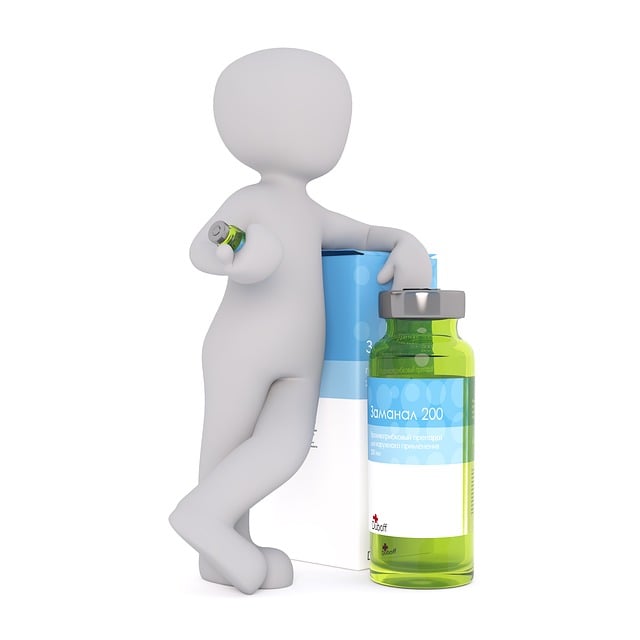GLP-1 drugs, mimicking natural hormone GLP-1, effectively manage Type 2 Diabetes by enhancing insulin secretion and suppressing glucagon release, lowering blood sugar levels. With growing global demand and expanding medical indications, these medications offer diverse, cost-effective treatment options. Advancements in formulation and delivery technologies have improved patient convenience, while value-based healthcare models further reduce costs. Generics have democratized access to GLP-1 drugs, providing long-term savings and preventing serious diabetes complications. Future strategies focus on negotiating prices, government interventions, enhanced manufacturing, and biosimilar development to make these life-changing medications even more affordable for patients worldwide.
“GLP-1 receptor agonists have emerged as a powerful tool in diabetes management, offering significant benefits for patients. This article explores the cost-effectiveness of these innovative GLP-1 drugs, delving into their role, market trends, and financial implications. From understanding their mechanism to analyzing treatment costs, we navigate the landscape of GLP-1 therapies. We discuss how these medications are transforming diabetes care while examining strategies to enhance accessibility and affordability. Get ready to discover the potential savings and future prospects of GLP-1 drugs in the ongoing quest for better diabetes management.”
Understanding GLP-1 Receptor Agonists: Their Role in Diabetes Management

GLP-1 receptor agonists, or GLP-1 drugs, are a class of medications designed to mimic the effects of the natural hormone glucagon-like peptide-1 (GLP-1). These drugs play a significant role in the management of type 2 diabetes by enhancing insulin secretion and suppressing glucagon release. This dual action helps lower blood sugar levels more effectively than traditional insulin therapy alone.
By activating GLP-1 receptors in the pancreas, these agonists stimulate insulin production in response to rising blood glucose, while also slowing gastric emptying, leading to improved satiety and reduced appetite. This multifaceted approach not only aids in glycemic control but also contributes to weight management, making GLP-1 drugs a promising option for diabetes treatment, especially with their cost-effectiveness becoming increasingly recognized in recent years.
The Rising Trend of GLP-1 Drugs: Market Overview and Growth Factors

The market for GLP-1 drugs has been on an upward trajectory, driven by a growing demand and expanding indications. These drugs, known as glucagon-like peptide-1 (GLP-1) receptor agonists, mimic the effects of the natural hormone GLP-1, which helps regulate blood sugar levels. The rising prevalence of diabetes and prediabetes globally has been a primary growth factor, as these medications offer an effective way to manage blood glucose without the side effects often associated with traditional insulin therapy.
Additionally, recent advancements in technology have led to improved formulations and delivery methods for GLP-1 drugs, enhancing their convenience and patient adherence. The increasing focus on cost-effectiveness and value-based healthcare has also contributed to the market’s growth. As these treatments provide long-term benefits while potentially reducing overall healthcare costs through better blood sugar control and reduced complications, they are becoming a preferred choice for both patients and healthcare providers.
Cost Analysis: Comparing GLP-1 Treatments for Type 2 Diabetes

When comparing cost-effectiveness, GLP-1 receptor agonists offer a range of treatment options for Type 2 Diabetes (T2D). These drugs have gained prominence in diabetes management due to their unique mechanisms and benefits. In terms of pricing, various factors influence the overall cost analysis. One key consideration is the dosage; different GLP-1 drugs have varying concentrations, requiring tailored dosing strategies. This can impact both patient outlay and healthcare system resources.
Additionally, the administration method plays a role. While some GLP-1 drugs are administered via injection, others offer once-daily oral formulations, which can be more cost-efficient for patients and healthcare providers alike. Moreover, generic versions of these medications have entered the market, significantly reducing treatment costs for individuals with T2D. This shift towards generics is a game-changer in ensuring accessibility and affordability without compromising quality.
Accessing Affordability: Insurance Coverage and Patient Assistance Programs

Accessing affordable GLP-1 receptor agonists is a significant aspect of ensuring treatment accessibility for those living with type 2 diabetes. Many insurance providers now offer coverage for these life-changing drugs, making them more attainable for patients. This includes various healthcare plans that cover prescription medications, allowing individuals to manage their blood sugar levels effectively without incurring substantial out-of-pocket expenses.
Patient assistance programs (PAPs) also play a crucial role in enhancing the affordability of GLP-1 drugs. These initiatives are designed to help patients who may face financial barriers to accessing necessary medication. PAPs often provide support in the form of discounts, coupons, or free supplies, making it easier for individuals to adhere to their treatment regimens without worrying about the cost. Such programs demonstrate a commitment to improving patient outcomes and ensuring that financial constraints do not limit access to essential GLP-1 drugs.
Generics vs Brand Names: Impact on Patient Out-of-Pocket Expenses

The introduction of generic versions of GLP-1 receptor agonists has significantly impacted the accessibility and cost-effectiveness of these important diabetes medications. Generics, being much cheaper than brand-name drugs, have reduced patient out-of-pocket expenses, making long-term treatment more affordable. This is particularly beneficial for patients with limited financial resources or those requiring lifelong insulin therapy.
Brand-name GLP-1 drugs, while often associated with higher initial costs, offer specialized formulations and potential advantages in terms of dosing flexibility and patient convenience. However, the emergence of generics has democratized access to these treatments, encouraging more individuals to initiate and sustain effective GLP-1 drug therapy for better blood sugar control.
Long-term Savings: Preventive Care and Reduced Complication Risks

The cost-effectiveness of GLP-1 receptor agonists lies not only in their direct therapeutic effects but also in the substantial long-term savings they offer. These drugs, primarily used for diabetes management, have been shown to reduce the risk of complications such as cardiovascular events and kidney failure. By preventing these costly and often life-threatening outcomes, GLP-1 drugs can significantly lower healthcare expenses over time.
Moreover, their role in preventive care cannot be understated. Regular use of GLP-1 therapies can help maintain healthy blood sugar levels, thereby reducing the likelihood of developing severe diabetes complications. This proactive approach to managing chronic conditions not only improves patient quality of life but also minimizes future medical expenditures associated with advanced diabetic complications.
Future Prospects: Negotiating Prices and Enhancing Cost-effectiveness

As the demand for GLP-1 receptor agonists continues to grow, future prospects in making these life-changing drugs more cost-effective are promising. Negotiating prices with pharmaceutical companies is a key strategy to improve accessibility and reduce out-of-pocket expenses for patients. This could involve government interventions, such as price caps or value-based pricing models, which align drug costs with their clinical value. Additionally, enhancing the manufacturing process to increase production efficiency and reduce waste can significantly lower costs without compromising quality.
Further research into biosimilar development and generic equivalents of GLP-1 drugs is also essential. Biosimilars offer a more affordable alternative to brand-name products while maintaining similar efficacy and safety profiles. Encouraging competition through these means has the potential to revolutionize the market, making GLP-1 drugs more accessible for those who need them most, thereby improving overall healthcare outcomes.
